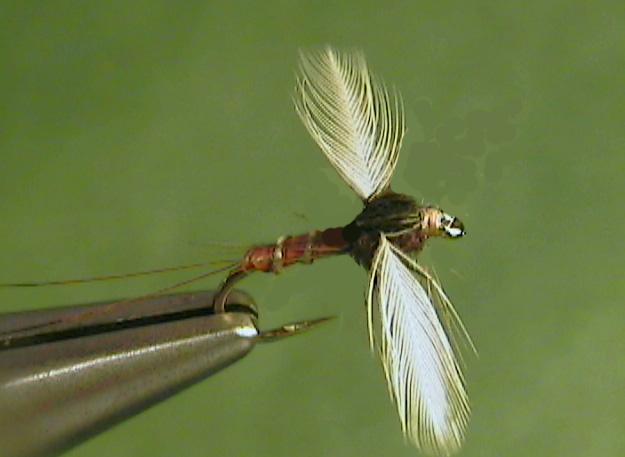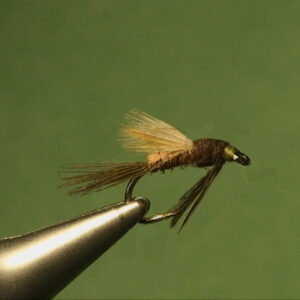Hook Size: 12/14
not notice them unless you are looking up towards the sky. The males fall spent first and
are joined by the females after their eggs have ripened and have been deposited in the
water. Not all the males will fall in the water. Many will fall on the banks but most of the
females will fall on the water.The spinner fall usually occurs in the late afternoon but is certainly possible for it to start
much sooner, especially when the skies are overcast or cloudy. Some days this may
occur only a short time after the hatch ends. I have even seen the spinner fall occurring
before the hatch ended but this is unusual. By the way, it’s not easy to see the trout
taking the spinners, fake or the real ones. They don’t crash them. They just sip them.
This leaves only a small ripple on the surface. If the water is fairly rough or fast, you may
never notice them. The spinners are also difficult to see on the water, especially in the
low light conditions they normally fall under.
The current will catch these spent spinners and move them into the current seams. The
trout will position themselves downstream along the current seams. The spinners will be
mixed right in with the bubbles. By the way, although this is out of place, note that the
tails of the male spinners are very, very long. All spinner tails and front legs are long, but
the male Quill Gordon are extremely long.
Spinner Presentation:
At times, trout can be taken using the Perfect Fly Dun imitating the upright wing female
spinners dipping to the water to deposit their eggs. Although the spinners looks different
from the duns, you can probably get by using the dun imitation for this. These imitations
should be presented in the faster water of ripples and runs. Where the spinners fall, the
water is rough and fast and the trout are not going to get a good look at your fly. The
presentation for imitating the upright wing spinner depositing her eggs should be the
same as if you were fishing any other dry fly except that It should only be presented in
the riffles and runs where the egg laying and spinner falls occur.
Spent spinner imitations are another thing. They usually work if they are presented below
the ripples and runs in the slower moving water of pockets, calmer water edges along the
banks, eddies and anywhere the current tends to congregate the spinners. The fly
should be more imitative of the real spent spinner in this case. The trout can examine the
spinners as much as they want too. They often get eaten in the slower moving, smoother
and calmer water. That is why our Pefect Fly Quil Gordon spinner is a simi-realistic
imitation of the real spinners.
The up and across presentation usually works best for the spinners. Make sure it drifts
drag-free. Mend the line if you need to. In some cases you may need to use a down and
across cast. If so, you should make a longer cast than normal. I suggest this only when
you observe trout taking the spinners downstream of your position or when that is the
only way to present the fly to a given area. It’s more difficult to keep the fly drifting drag
free and the trout from spotting you. Another suggestion is to use a longer than normal
leader, say 10 feet long and a longer, lighter tippet, say 6 X.



